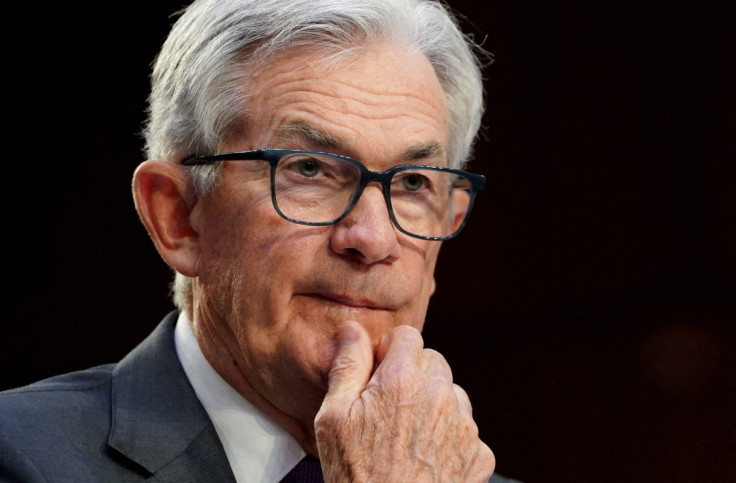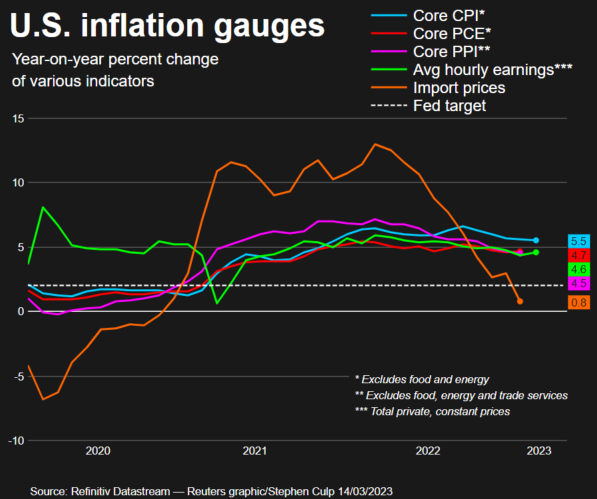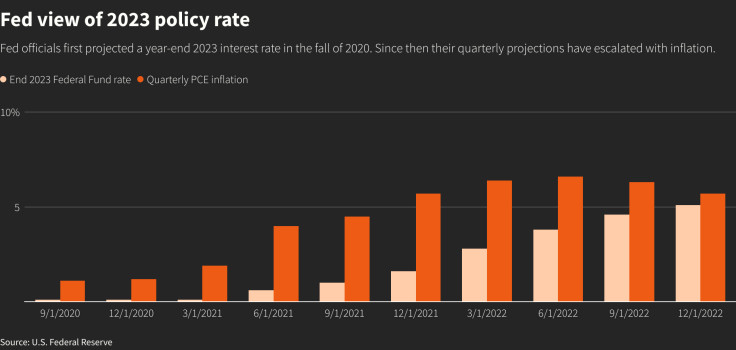Inflation Still A Front-burner Issue In The Hectic Fed Kitchen

Stubbornly high inflation, a robust job market, and an outbreak of financial stress have presented the Federal Reserve with a stark choice in the coming week: push ahead with interest rate hikes that could upend fragile markets or announce a pause that could weaken its unfinished fight against rising prices.
Despite designating a recent U.S. bank collapse as a "systemic risk," the U.S. central bank is currently expected to raise interest rates by another quarter of a percentage point at its March 21-22 policy meeting, with inflation still strong, the Fed's inflation-fighting credentials on the line, and financial markets calmed - for now - by a new liquidity program for banks.
An index of U.S. bank stocks rose on Tuesday as did the broader equity market. Yields on Treasury bonds, meanwhile, increased as investors discounted the likelihood that the Fed would shy away from further rate increases.
A quarter-percentage-point increase "is a justifiable way to trade off the relevant risks," said Narayana Kocherlakota, the former president of the Minneapolis Fed and now an economics professor at the University of Rochester in New York state.
The collapse of U.S. lender Silicon Valley Bank and the need to launch a new emergency program over the weekend likely undercut arguments for a larger hike, "but I don't think they will see (zero) basis points as the responsible move," he said.
"Among other issues, keeping rates flat would signal a lack of confidence in the financial stability enhancements that the government has provided."
It would also divert focus from the Fed's fight to defend its 2% inflation target, which officials up until SVB's March 10 failure declared was their single-minded priority. The Fed's preferred measure of inflation is running at almost three times the central bank's target.
Graphic-U.S. inflation gauges,

THIRD MANDATE
Fed policymakers are currently in a blackout period and cannot comment publicly about next week's meeting.
But only a week ago, in testimony to Congress just before the latest banking crisis erupted, Fed Chair Jerome Powell warned that interest rates would need to move higher and possibly faster than expected because inflation was proving more persistent than central bank officials had anticipated.
Stable prices and maximum employment are the Fed's core goals, but smoothly functioning financial markets are a de facto third mandate - something policymakers feel can make or break the central bank's other aims.
Policymakers took comfort in the fact that the sharp downturn and recovery from the COVID-19 pandemic did not turn into a financial crisis, in part because of Fed programs rolled out to keep markets functioning. Even if rate hikes raised the risk of recession, it was felt any downturn would be mild precisely because of the strength of the financial system.
The SVB failure, followed by the closure of a second U.S. bank over the weekend, fractured that calm and muddied what had been a clear policy narrative for the Fed of a resilient economy holding up well under tighter credit and higher borrowing costs.
The bias at the time Powell spoke was for Fed officials to issue new projections next week showing a higher stopping point for the benchmark overnight interest rate, and perhaps approving a half-percentage-point rate hike depending on what Powell called the "totality" of upcoming jobs and inflation data.
Graphic-Fed view of 2023 policy rate,

That information is now in hand, and on its own would have left the Fed debating just how aggressive to be, rather than how careful.
The U.S. Labor Department's monthly employment report last week showed continued strong job growth in February, while data released on Tuesday showed a key measure of consumer price inflation that excludes volatile food and energy components virtually unchanged from the month before - a sign of the persistence of price pressures.
Important aspects of both reports, however, moved in the favor of a more tempered Fed policy. Wage growth continued to slow in February, and much of the jump in prices last month was driven by the cost of shelter, an area where Fed officials feel inflation will soon prove to be slowing.
The developments in financial markets have changed the terms of the discussion, but haven't done anything to fix inflation that "remains a thorn in the Fed's side," said Ryan Sweet, chief U.S. economist at Oxford Economics.
While the bank lending facility introduced by the Fed over the weekend may have been motivated to protect depositors at the failed banks and reassure those at others, it also provided some insurance for policymakers who still feel rate increases are needed, but don't want to see their inflation fight evolve into a financial crisis.
"The Fed can support liquidity in the banking system and tighten monetary policy at the same time," Sweet said. "So odds are they continue to hike."
© Copyright Thomson Reuters 2024. All rights reserved.





















